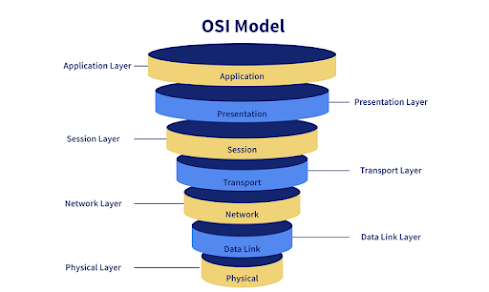The OSI model
The OSI model, also known as the Open Systems Interconnection model, is a conceptual framework that defines how data is communicated across a network. It's a universal language that helps us understand how different devices and software can connect and exchange information, regardless of the specific technology used.
The OSI model consists of seven layers, each with a specific function:
Layer 1: Physical Layer
Deals with the physical transmission of data bits across a network connection.
Examples: Cables (Ethernet, coaxial), wireless signals (Wi-Fi, Bluetooth)
Responsible for establishing and maintaining the physical connection between devices.
Layer 2: Data Link Layer
Packages data into frames and adds error detection mechanisms.
Examples: MAC addresses, error checking protocols (CRC)
Ensures reliable data transmission between network devices.
Layer 3: Network Layer
Routes data packets across networks based on their IP addresses.
Examples: IP addresses, routing protocols
Determines the path data takes to reach its destination network.
Layer 4: Transport Layer
Provides reliable data transfer between applications on different devices.
Examples: TCP (Transmission Control Protocol), UDP (User Datagram Protocol)
Ensures complete and in-order delivery of data packets.
Layer 5: Session Layer
Establishes, manages, and terminates sessions between communicating applications.
Examples: Session initiation and termination protocols
Coordinates communication between applications and ensures data exchange is synchronized.
Layer 6: Presentation Layer
Takes care of data formatting and encryption/decryption.
Examples: Image/video compression, data encryption standards
Prepares data for the application layer by ensuring it's presented in a compatible format.
Layer 7: Application Layer
Provides network services directly to user applications.
Examples: HTTP (web browsing), FTP (file transfer), SMTP (email)
The layer users interact with through applications like web browsers, email clients, etc.
Here's an analogy to understand the OSI model: Imagine sending a letter. The Physical Layer is like the envelope containing the letter. The Data Link Layer adds the address and ensures the envelope is properly sealed. The Network Layer is like the postal service that delivers the envelope based on the address. The Transport Layer makes sure the entire letter arrives without missing pages. The Session Layer coordinates the exchange between sender and receiver. The Presentation Layer might involve folding the letter for a mailbox or stuffing it into a bigger package for secure delivery. Finally, the Application Layer is the actual message written in the letter.
OSI and ISO are interrelated but serve different purposes:
ISO (International Organization for Standardization):
Function: An international non-governmental organization that sets standards for various industries, including communication, technology, and manufacturing.
Role in OSI Model: The OSI model was developed by ISO in the 1980s. ISO created the OSI model as a reference model to provide a common ground for understanding how different network devices and software can communicate across a network. It's not a specific protocol or technology itself, but rather a framework for understanding network communication.
OSI Model (Open Systems Interconnection model):
Function: A conceptual framework developed by ISO that defines network communication into seven layers.
Role: The OSI model describes the different stages involved in transmitting data over a network. Each layer performs specific tasks related to data packaging, addressing, transmission, and delivery.
Here's an analogy to understand their relationship:
Imagine ISO as a global committee that sets guidelines for international shipping. The OSI model would be a standardized framework they establish, outlining the steps involved in shipping a package, like packaging, addressing, routing, and delivery.
Benefits of the OSI Model:
Standardization: Provides a common language for discussing network communication.
Troubleshooting: Helps identify network issues by pinpointing problems within specific layers.
Interoperability: Guides the development of network protocols that can work together regardless of the underlying technology.
While the OSI model is a conceptual framework, many real-world network protocols don't strictly adhere to its seven layers. However, it remains a valuable tool for understanding network communication principles.
The OSI model is a reference model, meaning it doesn't represent the exact structure of all network protocols. However, it provides a valuable framework for understanding network communication and troubleshooting network issues. By understanding the functions of each layer, you can gain insights into how data flows across a network and identify potential problems at different stages.




Comments
Post a Comment